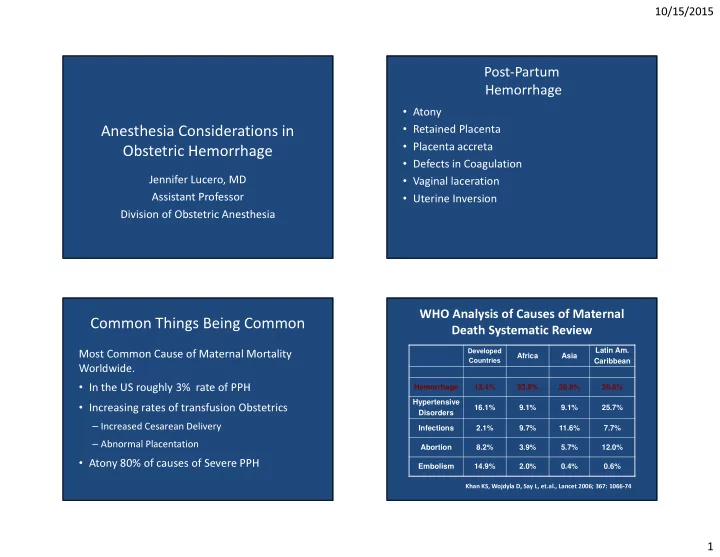

10/15/2015 Post-Partum Hemorrhage • Atony • Retained Placenta Anesthesia Considerations in • Placenta accreta Obstetric Hemorrhage • Defects in Coagulation • Vaginal laceration Jennifer Lucero, MD • Uterine Inversion Assistant Professor Division of Obstetric Anesthesia WHO Analysis of Causes of Maternal Common Things Being Common Death Systematic Review Latin Am. Developed Africa Asia Most Common Cause of Maternal Mortality Countries Caribbean Worldwide. Hemorrhage 13.4% 33.9% 30.8% 20.8% • In the US roughly 3% rate of PPH Hypertensive • Increasing rates of transfusion Obstetrics 16.1% 9.1% 9.1% 25.7% Disorders – Increased Cesarean Delivery Infections 2.1% 9.7% 11.6% 7.7% – Abnormal Placentation Abortion 8.2% 3.9% 5.7% 12.0% • Atony 80% of causes of Severe PPH Embolism 14.9% 2.0% 0.4% 0.6% Khan KS, Wojdyla D, Say L, et.al., Lancet 2006; 367: 1066-74 1
10/15/2015 Accreta and Peripartum Hysterectomy Flood KM, et al. Am J Obstet Gynecol. 2009; 200: 632 Anesthesiology 2014; 121:450-8 Creanga AA, et al. Obstet Gynecol. 2015; 125: 5-12 2
10/15/2015 Graphic Source: CMQCC California Maternal Quality Care Collaborative CMQCC Hemorrhage Task Force: • Developed a Tool Kit for OB services: – Set of Best Practices (short summaries of key aspects of OB hemorrhage) – Checklist for managing OB hemorrhage – Flow-Chart and Table Chart Summaries of approach – Implementation tools such as sample policies, procedures, charting examples, implementation hints • All resources on-line at: www.cmqcc.org/ob_hemorrhage Source:www.cmqcc.org/ob_hemorrhage Source: CMQCC California Maternal Quality Care Collaborative 3
10/15/2015 • Coagulopathy persisted at ICU admission Pre-ICU resuscitation: 9 ± 1 L crystalloid 12 ± 1 units PRBC 5 ± 0.4 units FFP FFP was not given until after 6 units PRBCs • In the ICU during resuscitation, patients received 10 ± 1 units FFP for coagulopathy; the ratio of FFP:PRBC was 1:1. Mean INR < 1.4 within 8 hours � Volume restoration is accomplished by using thawed plasma as � “Using the damage control resuscitation approach, the a primary resuscitation fluid in at least a 1:1 or 1:2 ratio with lack of intraoperative coagulopathic bleeding has been PRBCs remarkable, allowing surgeons to focus on surgical � Crystalloid is minimized and serves mainly as a carrier bleeding.” � The blood bank activates the massive transfusion protocol and deliver 6 units of plasma, 6 units of PRBCs, 6 packs of platelets, � “Patients treated in this fashion almost always arrive in and 10 units of cryoprecipitate the ICU warm, euvolemic, and nonacidotic, with a normal INR and minimal edema.” � Recombinant FVIIa is occasionally used 4
10/15/2015 2003-2005 Retrospective Data From Iraq War � “In the majority of patients the abnormalities of the lethal triad are absent.” � “These patients appear to be easily ventilated and more quickly extubated than patients with similar blood loss treated with the standard crystalloid resuscitation volumes and blood component ratios.” Borgman et al. J Trauma 2007; 63:805-13 Plasma:RBC product transfusion ratios effect on patient survival PLT:RBC product transfusion ratios effect on patient survival Survival versus ratio. (Dark Gray ) 24-hour survival; (Light Gray ) 30-day survival Survival versus ratio. (Dark Gray ) 24-hour survival; (Light Gray ) 30-day survival Volume 50, February 2010 TRANSFUSION Volume 50, February 2010 TRANSFUSION 5
Recommend
More recommend